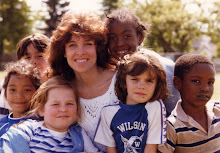This week I read with another 5th grader whose homeschooling mom wanted an idea of his strengths and needs as a reader. Bryce is an engaging, confident kid who described himself as someone who liked to read 5th grade books when he was a first grader, even though his first grade books were sometimes hard to read.
After hearing Bryce read from several books (my selections, his choice), I gave him the Burke Reading Interview (Goodman, Watson & Burke, 1987). Carolyn Burke is one of my mentors and this interview is a valuable tool for educators who want to learn more about how a reader makes sense of reading. (Readers who want to know more about this seemingly simple but carefully constructed and researched tool are encouraged to read more about it in the RC Owen Publishers text cited above.) Here are the questions with Bryce's responses.
BURKE READING INTERVIEW
When you are reading and come to something you don't know, what do you do? Sound it out for a long time or my mom helps me with it. Do you ever do anything else? Sometimes look in a dictionary.
Who is a good reader that you know? Why is s/he a good reader? Can I say two? Case and Olivia. Olivia was really advanced. She could read really well. She was so advanced for preschool so she automatically went into kindergarten. Case's parents worked with him until he got it.
Do you think s/he ever comes to anything s/he doesn't know? Probably. If s/he did, what do you think s/he would do? Sound it out. Look it up in a dictionary or on a computer.
If someone was having trouble reading, how would you help that person? Sound out each word with them. How would a teacher help? Help them figure it out.
Are you a good reader? Why? Medium. I can't read like 8th grade words, but I can read 5/6th grade. How did you learn to read? Sounding it out. When I was in first grade I could read like 5th grade words but it was hard to read first grade words.
What would you like to do better as a reader? Just continue practicing.
How could we help you more at school? At home? I get to pick what I want to read.
I invited Bryce to choose from 10-12 nonfiction books on the natural world (the 500 section of the library) and several short chapter books. He debated reading about worms or planets, then settled on worms. I asked him to read the table of contents, and we read the chapters that interested him most.
WHAT DID I LEARN?
Bryce is a happy kid and coming to read with me appeared to be comfortable for him. He was also an active learner and curious about the world around him: I know ants can be enemies to worms because I've seen ants crawling on a worm on the sidewalk. Is ring worm a worm? I know some other tall tales too, like the guy that caught tornadoes. These interests served him well when he selected books.
Bryce's primary strategy when he came to something he didn't know, as he reported, was sounding out words. This worked for him some of the time, and when it didn't, he looked to me for help. Taken together, these two behaviors disrupted the flow of his reading and weren't particularly successful or efficient. I asked him to guess the percentage of words that people can successfully "sound out." He guessed 7 out of 10, but the answer is closer to 5 out of 10.
After reading several short chapters, I asked him to choose another book and we talked about a couple more strategies readers use. He chose a book on weather and again read the table of contents. We turned to a chapter on electrical storms and I asked him to predict what he might read about. I was struck that he didn't look at the photograph on the opposite page (a full page photograph of lightning). (Often times readers will use strategies they don't name, and then teachers can help them be more aware--more metacognitive--of their reading behaviors. In this case, however, Bryce did what he reported doing: sounded out words and looked to me for help.)
This was the opportunity to share that good readers also look at the visual images. We turned to the chapter on hail storms, and used the picture to successfully predict words/concepts that he then was able to quickly locate on the page. I went back to the word lightning to illustrate that he might have gotten stuck sounding it out (a reader has to recognize ight, or will get bogged down sounding out each letter). Yet if he would had predicted that the text would include information on lightning, he would stand a better chance of successfully reading the text.
We ended our brief session with me complimenting Bryce's strengths as a reader and reminding him to add prediction and looking at illustrations to his growing repertoire of strategies.
Before reading:
1) Read the title and subtitles, and browse the illustrations.
2) Predict what the text will be about. What do you expect to read?
During reading:
1) use your knowledge of letters and sounds
2) use the illustrations
3) use your knowledge of the topic
After reading:
(Stay tuned for more information. One has to chose the one or two most important things to teach a learner if you want the teaching to be helpful, so this is where my session with Bryce ended.)
Subscribe to:
Post Comments (Atom)




No comments:
Post a Comment